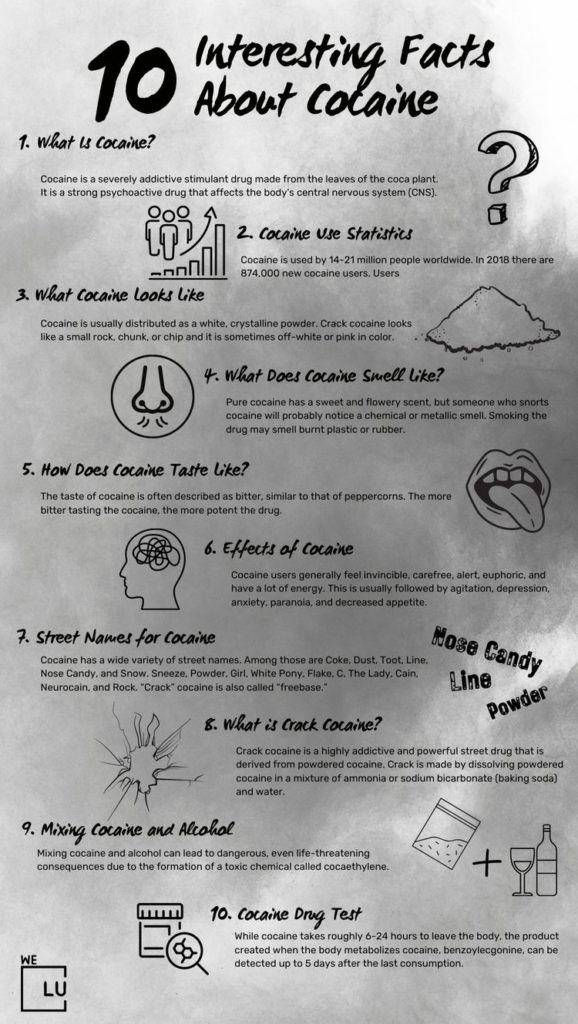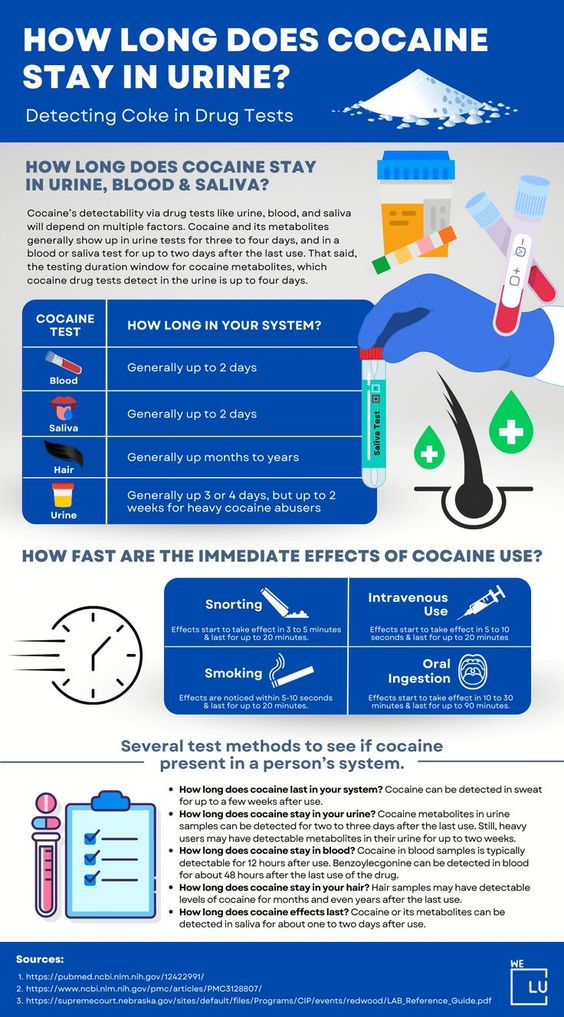10 Facts About Cocaine You Probably Did Not Already know
Cocaine is a highly addictive drug made from the leaves of the coca plant native to South America. Here are the Cocaine facts no one told you about:
- Cocaine is a powerful stimulant that increases dopamine levels, a neurotransmitter associated with pleasure and reward, in the brain. This causes a brief, intense feeling of euphoria and increased energy.
- Cocaine can be snorted, smoked, or injected. It is a white powder often cut with other substances such as talc, cornstarch, or sugar.
- Cocaine is illegal in most countries, including the United States, and is classified as a Schedule II drug under the Controlled Substances Act because of its high potential for abuse.
- Cocaine abuse can cause various physical and psychological effects, including constricted blood vessels, increased heart rate and blood pressure, insomnia, anxiety, and paranoia. Long-term use can lead to addiction and more severe medical issues such as heart attack, stroke, seizures, and respiratory failure.
- Cocaine is often associated with a high risk of overdose, as the dose required to produce a desired effect is small and can easily lead to unintentional poisoning. Overdose symptoms can include seizures, coma, and death.
Continue reading for the remaining 5 facts about Cocaine you probably didn’t already know.
10 Facts About Cocaine Continued
- Cocaine abuse can have devastating effects on individuals, families, and communities. It can lead to financial problems, legal issues, strained relationships, and career setbacks.
- Treatment for cocaine addiction may involve behavioral therapy, medication-assisted treatment, and support groups. It is important to seek help from a healthcare professional if you or a loved one is struggling with cocaine addiction.
- Cocaine addiction is a serious issue that can have significant physical and psychological effects. In addition to the physical symptoms mentioned earlier, it can lead to mental health problems such as anxiety disorders, depression, and even psychosis.
- The production and distribution of cocaine are often linked to organized crime and violence. It is a dangerous and illegal industry that can cause widespread harm to communities and individuals.
- While cocaine has been used for centuries for its stimulant and pain-relieving effects, its dangers and addictive potential have become more widely recognized in recent years. Public education and prevention efforts are critical in reducing the harm caused by cocaine use.
Top 10 Interesting Facts About Cocaine
Here are the top 5 facts about cocaine you probably don’t know. Cocaine’s facts may surprise you. Let’s begin:
1. What Is Cocaine?
Cocaine is a severely addictive stimulant drug made from the coca plant leaves. It is a strong psychoactive drug that affects the body’s central nervous system (CNS). Cocaine can be injected, smoked, sniffed, or snorted. It can be mixed with other drugs, including the anesthetic procaine and amphetamine. When cocaine and heroin are combined, it produces what is called a “speedball. When people discovered the drug’s euphoric effects, they quickly became addicted in large numbers. At this point, the U.S. government stepped in and outlawed the use of cocaine in commercial products.
2. Cocaine Use Statistics
Cocaine is a highly addictive illegal drug used by 14-21 million people worldwide. In 2018 there were 874,000 new cocaine users. Users can be from all economic statuses, all ages, and all genders. Since cocaine is combined or ‘cut’ with other chemicals, people have no idea if the dose will be weak or strong. These other chemicals may include fillers, such as paint chemicals, cornstarch, fentanyl, and its analogs, which are added purely to boost profits and often lead to the risk of cocaine perforated septum and cocaine and erectile dysfunction.
3. What Cocaine Looks Like
Cocaine is usually distributed as a white, crystalline powder. Crack cocaine looks like a small rock, chunk, or chip and is sometimes off-white or pink. What is the difference between crack cocaine and cocaine? Today, cocaine is a Schedule II controlled substance [2], which means that it has a high potential for abuse but can be administered by a doctor for legitimate medical uses, such as local anesthesia for some ear, eye, and throat surgeries. Cocaine was once thought to be a harmless drug and was even listed as an ingredient in Coca-Cola during the product’s initial heyday.
4. What Does Cocaine Smell Like?
Pure cocaine has a sweet and flowery scent, but the likelihood that someone with a history of cocaine use is buying a pure derivative is little to none. Because of the process of extracting cocaine from coca leaves — and the prominence of cheap cutting agents and additives in street-cut cocaine — the result is a more metallic smell. Some chemicals and additives combined with pure cocaine have distinctive smells, allowing the user to identify the ingredients in their batch of cocaine.
What cocaine smells like may also vary depending on the method of administration a person uses. Someone who snorts cocaine will probably notice a chemical or metallic smell, but someone who smokes the drug may smell burnt plastic or rubber. Cocaine with either gasoline or kerosene will give off a petroleum scent, such as the one you might smell after a diesel pickup truck passes you. What any particular batch of cocaine smells like is also affected by how it is used, such as intravenous injection, smoking, or snorting freebase cocaine. Some chemicals often used to manufacture cocaine have distinct smells that can help people identify the substance.
5. How Does Cocaine Taste Like?
Regardless of which additives, chemicals, and cutting agents are used in its production, cocaine always has a bitter and numbing taste, similar to that of peppercorns. The taste of cocaine is often described as bitter. The more bitter tasting the cocaine, the more potent the drug. While cocaine powder is not typically consumed in this manner, people will put cocaine in their mouths to check its purity. Specifically, a person will rub cocaine on their gums when checking purity.
Cocaine that has not been cut will typically numb the gum line when a small amount is rubbed. However, sometimes the cocaine will be cut with a numbing agent so that the result will be the same, and the person may have less pure cocaine without knowing it. For people who use cocaine, depression after use is common, even when they do not use it regularly. The reason cocaine and depression have this relationship relates to how the brain works.
Below are the top remainder 10 facts about cocaine use:
6. Effects of Cocaine
Cocaine creates a strong sense of exhilaration. Users generally feel invincible, carefree, alert, euphoric, and have a lot of energy. This is usually followed by agitation, depression, anxiety, paranoia, and decreased appetite. The effects of cocaine generally last up to one hour. This drug is a potent and dangerous substance. The short-term and long-term effects of cocaine are equally serious. The most serious danger of cocaine use is cardiac arrest or seizures followed by respiratory failure.
7. Street Names for Cocaine
Cocaine has a wide variety of street names
Cocaine’s street names include:
- Coke.
- Dust.
- Toot.
- Line
- Nose Candy.
- Snow is among Cocaine’s street names.
- Sneeze.
- Powder.
- Girl.
- White Pony.
- Flake.
- C.
- The Lady.
- Cain.
- Neurocain.
- and Rock.
- “Crack” cocaine is also called “freebase.”
Fun Facts About Cocaine Infographics
While Cocaine’s high may be considered fun by some, Cocaine’s facts are typically not fun. To begin, did you know that Cocaine can be very expensive? Many users may go to great lengths to obtain the drug. This can lead to illegal activities such as theft, prostitution, and drug trafficking.
Another Cocaine fact, Cocaine addiction is a treatable condition. But it requires a comprehensive approach to treatment. This includes medical detoxification to manage withdrawal symptoms safely and a customized treatment plan that may include behavioral therapy and medication-assisted treatment.

Skip To:
Sure, here are 3 funded facts about cocaine:
Link To:
- Cocaine Detox
- Cocaine Addiction
- How To Get Cocaine Out Of Your System Safely, Detox, & Professional Help
- Working Out On Cocaine
- Cocaine Tolerance
- The Dangers Of Mixing Cocaine and Viagra, Effects, & Abuse
- Sex and Cocaine
- DXM and Cocaine
- Cocaine And The Heart
- Is Cocaine A Blood Thinner?
- Slang Names For Cocaine
- How Long Does Cocaine Stay in Your System? How Long Does Cocaine Stay in Urine?
- Cocaine Effects On The Brain
- Is Cocaine a Stimulant or Depressant?
- Cocaine Myths
- Signs of Cocaine Overdose
- What Does Cocaine Smell Like? What Does Cocaine Taste like? What Does Cocaine Look Like? How to ID Cocaine?
- What Is Pink Cocaine? Pink Coke Sife Effects, Dangers, Pink Drug Harmful Effects & Treatment Options
- Cocaine and Depression
Cocaine use and addiction can have serious physical, mental, and social consequences, and treating the issue with the appropriate level of seriousness and concern is important. It is always recommended to avoid using cocaine or any other illicit substances and to seek professional help if you or someone you know is struggling with drug addiction.

Get Your Life Back
Find Hope & Recovery. Get Safe Comfortable Detox, Addiction Rehab & Dual Diagnosis High-Quality Care.
Hotline(844) 597-10118. What is Crack Cocaine?
Crack cocaine is a highly addictive, powerful street drug derived from powdered cocaine. Crack is made by dissolving powdered cocaine in a mixture of ammonia or sodium bicarbonate (baking soda) and water. The mixture is boiled until a solid substance forms. It is removed from the liquid, dried, broken into chunks (rocks), and sold as crack cocaine.
Due to its availability and intense effects, crack is also popular. Health risks and problems resulting from crack use are the same as those listed for cocaine. However, because of the intensity of the drug, it is a higher risk.

9. Mixing Cocaine and Alcohol
Alcohol is often consumed alongside other illicit substances, making some wonder what happens when you mix cocaine and alcohol. Mixing cocaine and alcohol can lead to dangerous, even life-threatening consequences due to the formation of a toxic chemical called cocaethylene. Thus, it is critical to avoid using cocaine and alcohol together.
There’s a myth out there about using cocaine and alcohol together. People believe taking both can boost the cocaine high and help avoid withdrawal. This is just not true. Mixing cocaine and alcohol can have deadly results. Cocaine and alcohol don’t negate the effects of one another. They mask the effects, making people unaware of how intoxicated they are, leading to alcohol poisoning and cocaine overdose.
10. Cocaine Drug Test
Cocaine drug tests work not by searching for the presence of Cocaine but for proof that the body has recently metabolized, proving the ingestion of cocaine. While cocaine takes roughly 6-24 hours to leave the body, the product created when the body metabolizes cocaine, benzoylecgonine, can be detected up to 5 days after the last consumption. Metabolites are substances that our bodies create after metabolizing a certain toxic substance. Metabolizing cocaine usually takes between 6 and 24 hours, depending on an individual’s height, weight, and metabolism speed.
Another factor that plays an important role in cocaine drug testing is the consumption of alcohol during and after the consumption of cocaine. Unlike most other drugs, cocaine reacts with alcohol to create a new substance called cocaethylene. This substance has a longer half-life than benzoylecgonine, which will be detectable in one’s system for longer. In most cases, cocaethylene takes up to seven days to be completely cleaned out of a person’s body, provided they do not consume more cocaine or alcohol and remain properly hydrated during this period.
Fun 3 Facts About Cocaine
Here are 3 fun facts about cocaine that, while interesting, are not funny:
- Cocaine use has various negative health effects, including cardiovascular disease, respiratory problems, and mental health disorders such as depression and anxiety. Cocaine is also a significant cause of drug-related deaths.
- Cocaine addiction is a complex issue that requires specialized treatment. While abstinence from cocaine is the ultimate goal of treatment, effective treatment should also focus on improving overall health and functioning, addressing underlying mental health issues, and addressing social and environmental factors that contribute to addiction.
- Prevention and harm reduction strategies are critical for reducing the harm associated with cocaine use. Strategies such as education programs, drug testing, and safer drug-use techniques can help reduce the negative consequences of cocaine use and promote safer behaviors. Additionally, expanding access to evidence-based treatments such as cognitive-behavioral therapy and medication-assisted treatment can help individuals struggling with addiction to recover and live healthier lives.
Fun facts about cocaine may distort the drug’s harm. Cocaine is a highly addictive and harmful drug that should not be trivialized or glamourized in any way.
Drug Testing Cocaine Facts Infographics
Here are the facts about drug testing for cocaine:
- Cocaine can be detected through various drug tests, including urine, blood, hair, and saliva tests. The time that cocaine can be detected varies depending on the test method.
- The most common drug test for cocaine is the urine test, which can detect the drug for up to 4 days after use for occasional users and up to 12 days for chronic users.
- Hair drug testing for cocaine is the most accurate and can detect the drug for up to 90 days after use, but it is also the most expensive and time-consuming method.
- False positive results for cocaine drug tests can occur due to other bodily substances, such as lidocaine or other local anesthetics.
- Employers may require drug testing for cocaine and other drugs as part of workplace drug policies, and certain industries, such as transportation and healthcare, may have mandatory drug testing requirements.
It is critical to note that drug testing is not a perfect science and can have limitations and inaccuracies. It is always recommended to seek professional help if you or someone you know is struggling with drug addiction.

There Are Serious Health Risks to Using Cocaine
With repeated exposure to cocaine, the brain adapts, making the reward pathway less sensitive to natural reinforcers. At the same time, circuits involved in stress become increasingly sensitive, leading to increased displeasure and negative moods when not taking the drug, which are signs of withdrawal. These combined effects make the user more likely to focus on seeking the drug instead of relationships, food, or other natural rewards.
With regular use, tolerance may develop so that higher doses, more frequent use of cocaine, or both are needed to produce the same level of pleasure and relief from withdrawal experienced initially. At the same time, users can also develop sensitization, in which less cocaine is needed to produce anxiety, convulsions, or other toxic effects. Tolerance to cocaine reward and sensitization to cocaine toxicity can increase the risk of overdose in a regular user.
How Long Does It Take To Get Addicted To Cocaine?
The method by which cocaine is used—whether injected, smoked, snorted, or taken orally—can impact the high’s duration and intensity. For example, snorting cocaine can give a relatively slow onset of the high, lasting 15 to 30 minutes. This is because it has to get through mucus, skin, and other tissues before hitting your bloodstream. Smoking this drug, however, will result in more rapid effects that last five to 10 minutes. But this high is typically instantly followed by a crash that can cause anxiety, tension, agitation, depression, and exhaustion. It’s this quick cycle that makes this illegal stimulant so addictive.
Cocaine sends intense signals to the brain’s pleasure centers, increasing alertness and a “high” feeling. Cocaine use can alter the brain after just one use, and regular use can lead to intense cravings, withdrawal, and neurological changes.
Get Help. Get Better. Get Your Life Back.
Searching for Accredited Drug and Alcohol Rehab Centers Near You?
Even if you have failed previously and relapsed, or are in the middle of a difficult crisis, we stand ready to support you. Our trusted behavioral health specialists will not give up on you. When you feel ready or just want someone to speak to about therapy alternatives to change your life call us. Even if we cannot assist you, we will lead you to wherever you can get support. There is no obligation. Call our hotline today.
(844) 597-1011Cocaine Effects on Sperm
Cocaine can disrupt men’s sperm counts. Cocaine binds to receptors on cells in the testicles and decreases sperm production. When cocaine binds to these receptors, the sperm cells are constructed incorrectly, and the cellular structures cannot survive. The cells die early and cannot mature into healthy, functioning sperm.

When cocaine enters the bloodstream, it increases neurotransmitters (chemical signals) like dopamine and norepinephrine. These neurotransmitters are important for developing new cells and tell the cells how to build their inner structures correctly. Therefore, these signals must be carefully regulated to produce new functioning sperm cells. Additionally, cocaine also causes blood vessels to constrict (tighten) and deliver less oxygen to some tissue. The cells can die if the tissue loses blood flow and oxygen over time.
According to the National Center for Biotechnology Information (NCBI), the ability of cocaine to decrease the percentage of motile sperm at high concentrations may explain the decreased sperm motility associated with cocaine use. Cocaine’s ability to augment sperm penetration at low concentrations suggests an interaction of cocaine with the sperm adrenergic system.
Does Cocaine Cause Erectile Dysfunction?
According to the National Center for Biotechnology Information (NCBI), Sexual dysfunction is not uncommon in alcoholics and in cocaine users. Forty to 50% of alcoholic men suffered erectile dysfunction, and 5-10% had retarded or inhibited ejaculation. Thirty to 36% of cocaine abusers reported erectile dysfunction. Alcohol abuse frequently develops along with cocaine dependence, and the reverse is also common.
Cocaine is a potent dopamine agonist, and chronic cocaine abuse may result in hyperprolactinemia or a dopamine deficiency with sexual dysfunction. Chronic cocaine or alcohol abuse often leads to decreased libido and performance. In addition, acetylcholine turnover usually increases when dopamine is depleted. Therefore, cocaine- and alcohol-induced catecholamine depletion may activate acetylcholine, further contributing to hyperprolactinemia and sexual dysfunction. In addition, abuse of these substances alters serotonin, acetylcholine, hormones, and other neuroendocrine functions.
First-class Facilities & Amenities
World-class High-Quality Addiction & Mental Health Rehabilitation Treatment
Rehab Centers TourRenowned Addiction Centers. Serene Private Facilities. Inpatient rehab programs vary.
Addiction Helpline(844) 597-1011Proven recovery success experience, backed by a Team w/ History of:
15+
Years of Unified Experience
100s
5-Star Reviews Across Our Centers
10K
Recovery Success Stories Across Our Network
- Low Patient to Therapist Ratio
- Onsite Medical Detox Center
- Comprehensive Dual-Diagnosis Treatment
- Complimentary Family & Alumni Programs
- Coaching, Recovery & Personal Development Events
Cocaine Effects on Teeth
Cocaine users experience an increased rate of tooth decay for a variety of reasons: the drug contributes to xerostomia, the user does not seek regular professional care or perform regular personal oral care, and they may rub the drug directly onto the gingival tissue resulting in tooth erosion.
Users sometimes rub cocaine over their gums, causing ulceration of the gums and the underlying bone. Cocaine mixed with saliva creates an extremely acidic solution that erodes tooth enamel and exposes the underlying dentine to decay-causing bacteria. Cocaine and crack cocaine cause dry mouth, further increasing tooth decay risk.
Cocaine can cause tooth wear by tooth grinding (bruxism). Clenching and grinding destroy the supporting structures, leading to cervical abrasion and occlusal wear.
Cocaine and Dopamine
The brain registers all pleasures similarly, whether they originate with a psychoactive drug like cocaine, a monetary reward, a sexual encounter, or a satisfying meal. In the brain, pleasure has a distinct signature: the release of the neurotransmitter dopamine in the nucleus accumbens, a cluster of nerve cells lying underneath the cerebral cortex. Dopamine release in the nucleus accumbens is so consistently tied with pleasure that neuroscientists refer to the region as the brain’s pleasure center.
All drugs of abuse, from cocaine, nicotine to heroin, cause a particularly powerful surge of dopamine in the nucleus accumbens. The likelihood that the use of a drug or participation in a rewarding activity will lead to addiction is directly linked to the speed with which it promotes dopamine release, the intensity of that release, and the reliability of that release.
Even taking the same drug through different administration methods can influence how likely it is to lead to addiction. Smoking cocaine or injecting it intravenously, instead of swallowing it, for example, generally produces a faster, stronger dopamine signal and is more likely to lead to drug abuse.
In the normal neural communication process, dopamine is released by a neuron into the synapse, where it can bind to dopamine receptors on neighboring neurons. Normally, dopamine is recycled back into the transmitting neuron by a specialized protein called the dopamine transporter. If drugs like cocaine are present, it attaches to the dopamine transporter. It blocks the normal recycling process, resulting in a buildup of dopamine in the synapse, which contributes to the pleasurable effects of cocaine.
Coca Cola Fun facts about Cocaine

Cocaine Euphoria
The cocaine euphoria or high, also known as cocaine intoxication, is one of the most widely recognized cocaine effects among cocaine users. The high is often the main reason for taking cocaine. This is true for people who are experimenting with cocaine use, are occasional cocaine users, binge cocaine users, and people in the early stages of cocaine addiction.
The cocaine high involves psychological changes, which are changes to how the person thinks and feels emotionally and physically. Some of these changes are caused by the effects of cocaine on the brain and nervous system, and some are due to personal feelings that the cocaine user brings to the experience.
This is why, although there are similarities among cocaine users’ experiences of cocaine high, the effects of cocaine are different for each person. So although aspects of cocaine intoxication are common among cocaine users, they may experience some, but not all, of these cocaine effects.
Can a Person Become Addicted to Cocaine?
All forms of the drug are highly addictive. Some people can get addicted after using it for a short time. Cocaine is a highly addictive drug, but it may be hard to recognize addiction. Craving Cocaine and ignoring the consequences that come with it are signs of an addiction.
Psychological addiction is often the hardest part to overcome, although there are undeniable physical symptoms of addiction as well. Someone who uses Cocaine frequently will develop a dependence on it, meaning they need to have it to feel normal. Once dependence has developed, tolerance and withdrawal symptoms will occur when stopping use.
Once someone becomes addicted to Cocaine, it can be very hard to stop. This is because Cocaine abnormally increases the level of dopamine in the brain, eventually reprogramming the brain reward system.
Cocaine Addiction
The user can become addicted to cocaine after the first use due to its powerful effects and sensations of pleasure and intense well-being, feeling more mentally alert, and heightened sexual arousal. Repeated exposure to cocaine results in neuroadaptation. This includes sensitization, increased drug response, and tolerance or decreased drug response. In other words, your body will crave more of the drug for the same effect.
Physical signs of cocaine addiction include:
- Unhealthy weight loss
- Increased heart rate
- Nausea
- Abdominal pain
- Headaches
- Chest pain
- Heart arrhythmia
- Heart attack
- Seizure
- Stroke
Psychological signs of cocaine addiction include:
- Paranoia
- Panic
- Hallucinations
- Aggression
- Irritability
- Anxiety
- Depression
- Impaired judgment
- Repetitive or abnormal behaviors
World-class, Accredited, 5-Star Reviewed, Effective Addiction & Mental Health Programs. Complete Behavioral Health Inpatient Rehab, Detox plus Co-occuring Disorders Therapy.
CALL(844) 597-1011End the Addiction Pain. End the Emotional Rollercoaster. Get Your Life Back. Start Drug, Alcohol & Dual Diagnosis Mental Health Treatment Now. Get Free No-obligation Guidance by Substance Abuse Specialists Who Understand Addiction & Mental Health Recovery & Know How to Help.
Cocaine Addiction Treatment Near Me
First and foremost, if you think that a loved one is abusing cocaine, you should first research the drug and associated addiction to better understand what you loved one needs. Next, you must plan an intervention to provide your loved ones with options to battle their addiction in a safe and supportive environment. During this intervention, make sure that you offer compassion and support instead of judgment. Lastly, offer your support throughout the entire treatment process.
In addition, prolonged Cocaine use can have severe physical and psychological effects, so seeking treatment as soon as possible is essential. Inpatient drug rehab offers intensive care that can help you promptly get through the early stages of withdrawal. Now that revealed the “10 Interesting Facts About Cocaine” can be a good start in learning more about cocaine addiction.
Medically-Assisted Detox
Detox is often considered the first stage of treatment. It will help you navigate the complicated withdrawal process but doesn’t address patterns of thought and behavior contributing to drug use. Various treatment approaches and settings can help provide the ongoing support necessary to maintain long-term sobriety after you complete detox.
Cravings are very common during detox and can be challenging to overcome. This often leads to relapse. Constant medical care provided during inpatient treatment helps prevent relapse. Clinicians can provide the necessary medication and medical expertise to lessen cravings and the effects of withdrawals.
Psychotherapy
Several different modalities of psychotherapy have been used in the treatment of mental health disorders along with addiction, including:
- Cognitive Behavioral Therapy (CBT) – is an effective treatment that involves changing both the patterns of negative thoughts and the behavioral routines which are affecting the daily life of the depressed person for various forms of depression.
- Dialectical Behavior Therapy – is a comprehensive mental health and substance abuse treatment program whose ultimate goal is to aid patients in their efforts to build a life worth living. The main goal of DBT is to help a person develop what is referred to as a “clear mind.”
- Person-Centered Therapy – is a strategy that allows and encourages clients to understand and resolve their concerns in a safe, supportive environment.
- Solution Focused Therapy – is an approach interested in solutions that can be quickly implemented with a simple first step leading to further positive consequences.
Dual Diagnosis Treatment
Drug abuse and mental health disorders often co-occur. Traumatic experiences can often result in mental health disorders and substance abuse. Dual diagnosis rehabilitation treats both of these issues together. The best approach for the treatment of dual diagnosis is an integrated system. This strategy treats both the substance abuse problem and the mental disorder simultaneously. Regardless of which diagnosis (mental health or substance abuse problem) came first, long-term recovery will depend largely on the treatment for both disorders done by the same team or provider.
Medication-Assisted Treatments
Medication-Assisted Treatments (MAT) for substance use disorders and mental health disorders are commonly used in conjunction. This includes the use of medications and other medical procedures. During your rehab, the staff from your treatment facility will help you identify what caused your addiction and teach you skills that will help you change your behavior patterns and challenge the negative thoughts that led to your addiction. Sometimes, the pressures and problems in your life make you rely on substances to help you forget about them momentarily.
Please, do not try to detox on your own. The detox process can be painful and difficult without medical assistance. However, getting through the detox process is crucial for continued treatment. We Level Up provide proper care with round-the-clock medical staff to medically assist your recovery. So, reclaim your life, and call us to speak with one of our treatment specialists. Our counselors know what you are going through and will answer any of your questions.

Experience Transformative Recovery at We Level Up Treatment Centers.
See our authentic success stories. Get inspired. Get the help you deserve.
Start a New Life
Begin with a free call to an addiction & behavioral health treatment advisor. Learn more about our dual-diagnosis programs. The We Level Up Treatment Center Network delivers recovery programs that vary by each treatment facility. Call to learn more.
- Personalized Care
- Caring Accountable Staff
- World-class Amenities
- Licensed & Accredited
- Renowned w/ 100s 5-Star Reviews
We’ll Call You
Watch the Cocaine Facts and Cocaine Drug Test Video
Sources:
[1] NIDA – https://www.drugabuse.gov/publications/research-reports/cocaine/what-scope-cocaine-use-in-united-states. Find the facts about Cocaine.
[2] SAMHSA – https://www.samhsa.gov/data/sites/default/files/cbhsq-reports/NSDUHNationalFindingsReport2018/NSDUHNationalFindingsReport2018.pdf Learn the facts about Cocaine.
[3] NIDA – https://www.drugabuse.gov/drug-topics/trends-statistics/overdose-death-rates. Facts about Cocaine overdose.
[4] NCBI – https://pubmed.ncbi.nlm.nih.gov/22934772/ The facts about Cocaine.
[5] Cocaine Overdose – We Level Up NJ. Facts about Cocaine overdose dangers.


